Best telescopes for seeing planets in 2024
These are the best telescopes for seeing planets. Find the perfect scope to get great views of our celestial neighbors — our recommendations.
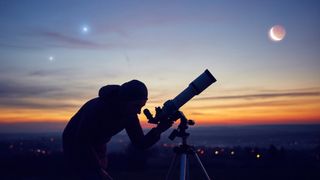
1. The list in brief ↴
2. Best overall
3. Best for planetary imaging
4. Best for portability
5. Best for beginners
6. Best combination package
7. Best for precision
8. Best for functionality
9. Best budget option
10. Best telescopes for seeing planets FAQ
11. How we test
Having one of the best telescopes for seeing planets is critical if you want to get up close and personal with our solar system. These telescopes allow you to see beautiful views of Venus, Mars, Jupiter or Saturn and its rings, and on this list we've considered a variety of different price points and abilities.
Even when they're part of our solar system, planets are distant objects in the night sky. However, their brightness compared to other celestial objects means they're excellent subjects to observe via a telescope. Some telescopes are better at observing planets than others, and so we've chosen models with great resolutions and a high magnification range, allowing you to see planets as clearly as possible.
Telescopes come in a vast array of price brackets, and in this guide to the best telescopes for seeing planets, you'll find everything from budget-friendly telescopes to those costing well over four figures. Whether you're brand new to astronomy or a professional, then, you should find something to suit. Everything on this list has been selected by our expert reviewers, and for many of the models, you'll find separate, in-depth reviews to give you even more information.
If you're interested in skywatching more broadly, take a look at our guide to the best telescopes, or to the best beginner telescopes if you're just starting out on your astronomy journey. The best binoculars can also be a powerful (and portable!) accessory for skywatching, especially if you intend to be on the go a lot. If you're looking for a gift for the budding astronomers in your family, then our guides to the best telescopes for kids and best binoculars for kids may be just what you're looking for.

Tom Kerss F.R.A.S. is a London-based astronomer, astrophotographer, author and consultant. Having previously worked at the Royal Observatory in Greenwich, he is the founder of Stargazing✦London, which delivers world-class online astronomy and space courses with subject experts. Tom is also the host of the Star Signs podcast, providing updates from the world of space news, as well as what to look out for in the night sky.
The quick list
See our quick list below if you want to dive right in, or scroll further down for more detailed reviews of each product.
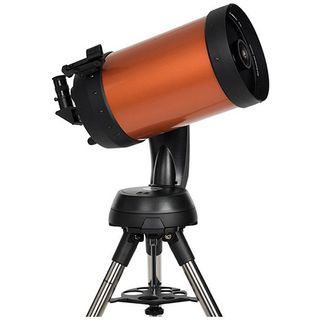
Best telescope overall
The price is steep, but the optics and quality of this telescope are unmatched. It offers incredible views of the planets, as well as being capable of displaying further deep-sky objects.
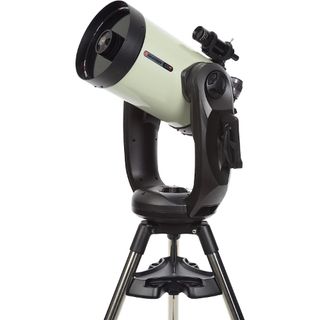
Best for planetary imaging
The huge 11-inch aperture on this telescope makes it supremely good for planetary imaging. It will allow you to get a detailed surface view of even the most distant planets in our solar system.
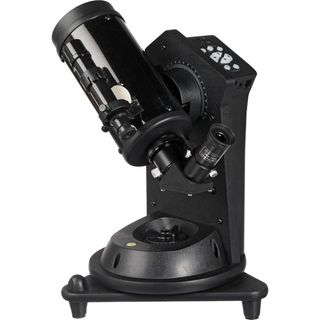
Best for portability
This telescope packs a big punch in a small and compact package. With only a 28cm tube, you can still view the planetary surfaces in rich detail, and it also comes with a smooth motorized mount.
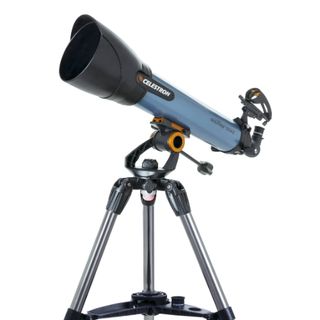
Best for beginners
This is a great affordable option for beginners looking to get a better view of the planets. It also comes with a handy smartphone mount so you can take photos of whatever you're viewing with ease.
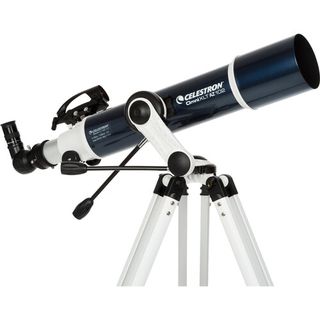
Best combination package
This is an ideal package for a quick set-up. You get a good telescope for viewing the planets in detail, along with an equatorial mount, with no tools required to set it all up.
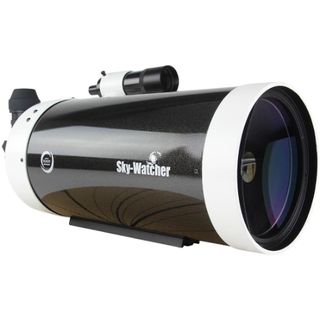
Best for precision
With a high-resolution and long focal-length optical system, this telescope can produce stunning views of the planets. With its 7.1-inch aperture, you'll also be able to catch a glimpse of some of the solar system's many moons.
Load the next 2 products ↴
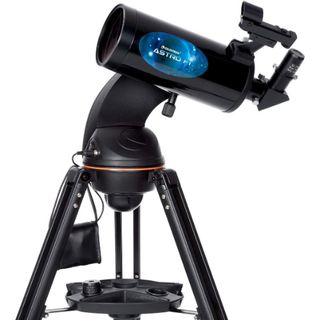
Best for functionality
This is a great option for those who enjoy using a smartphone app alongside their telescope. You can use the SkyPortal app to instruct the telescope to automatically slew to a celestial body of your choice.
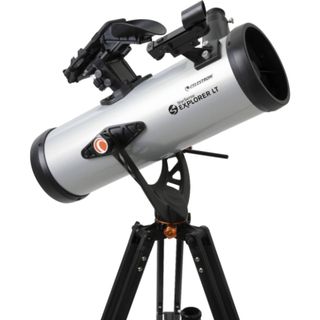
Best budget option
With quick and easy alignment and a very affordable price point, this telescope makes a great option for beginners on a budget. It will give you high magnification of the planets and the moon.
Best telescopes for seeing planets we recommend in 2024
Why you can trust Space.com
Best telescope overall








Specifications
Reasons to buy
Reasons to avoid
✅ You're looking for outstanding optics: This telescope produces incredibly bright and sharp views of the planets and moons in our solar system.
✅ You like to get hands-on with your telescope: The effective handheld remote on this telescope will suit anyone who prefers traditional telescope controls over using an app.
❌ You're a beginner exploring stargazing for the first time: This telescope is a significant investment, so unless you have a sizeable budget we'd recommend starting out with a simpler, more affordable model.
❌ You want to be able to control your telescope with an app: Some of the other models on this list, such as the Celestron Astro Fi 102, offer a more app-friendly design.
🔎 Celestron NexStar 8SE: While an expensive investment, it will last for decades and is one of the best you can buy. Experienced astronomers will love the motorized mount and the option to add accessories. It makes a great companion for astrophotographers too. ★★★★½
Part of Celestron's successful range of NexStar telescopes, it's easy to see why this particular model is the company's star buy. It's expensive but is a seriously impressive product, as we found in our in-depth Celestron NexStar 8SE review.
This telescope has a high-quality Schmidt-Cassegrain optical design, which lets it absorb a huge amount of light. That means you can not only see the planets with breathtaking amounts of detail, but you can use the NexStar 8SE to gaze into the deep sky, too.
Smaller apertures are available in the NexStar 4SE, 5SE and 6SE models, but none compare to the awe-inspiring views offered by this 8-inch aperture, which lets in a whopping 78% more light than the NexStar 6SE.
While the Celestron NexStar 8SE comes with a price tag of around $1,500, its capabilities and features make it a valuable investment for beginners to experienced astronomers. With a database of 40,000 celestial objects and a 'tour mode' guiding you through popular targets, it provides a user-friendly experience for those not well-versed with the night sky.
The motorized single fork arm mount allows you to smoothly slew to your selected object using the handheld remote. Once it's aligned, the NexStar 8SE provides crystal clear views across the entire field of view, and it's compatible with many accessories.
Although the price is high, we were impressed by its durable build, including a sturdy steel tripod that's easily portable for dark sky sites. With proper care, this telescope has the potential to last for decades. If it fits your budget, the quality justifies the investment. However, if it's a bit beyond your budget, the rest of the list offers competitive alternatives that are worth considering.
- Read our full Celestron NexStar 8SE review
| Attributes | Notes | Rating |
|---|---|---|
| Design | Solid scope with a hands-on feel. | ★★★★★ |
| Performance | Outstanding optics and sharp views. | ★★★★★ |
| Functionality | Quick to set up and store away. | ★★★★ |
Best for planetary imaging
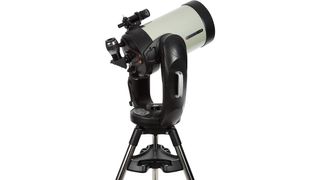
Celestron CPC Deluxe 1100 EdgeHD
Our expert review:
Specifications
Reasons to buy
Reasons to avoid
✅ You want the biggest aperture you can get: its 11-inch high-performance mirror is the biggest on our list, offering huge magnification.
✅ Planetary imaging is your primary goal: this telescope can render even the most distant planets in fine detail.
❌ You're on a budget: this telescope is astronomically expensive and there are many cheaper models out there.
❌ You don't want to be buying extra accessories: this telescope only comes with one eyepiece supplied in the box.
🔎 Celestron CPC Deluxe 1100 EdgeHD: if your budget can stretch to it, this telescope will give you an incredible view of the surface of any planet in our solar system, with magnification to spare. ★★★★½
Taking images of planets is a captivating hobby, and luckily, you can get started with any telescope that has a tracking mount. If you're serious about capturing images of our neighboring worlds, you'll need a telescope with a large aperture.
The Celestron CPC Deluxe 1100 EdgeHD allows you to see more than just the planets: Thanks to its huge 11-inch main mirror, you can enjoy intricate details of the surfaces of distant planets. If you're viewing Venus and Jupiter, expect to see a remarkable amount of surface detail. Even casual users will be able to easily find details such as deserts and dust storms on the surface of Mars. In other words, this is an incredible bit of kit.
The downside is that the CPC Deluxe 1100 EdgeHD doesn't come cheap. It's the most expensive telescope on this guide by quite a margin, which means it's probably not going to be suitable for amateur skywatchers. But for experienced astronomers or those with a very stretchy budget, you absolutely won't be disappointed with this telescope's capabilities.
The CPC mount is dependable and robust, offering precise tracking for extended imaging sessions. If you're interested in deep-sky astrophotography, you can convert it into an equatorial platform using a wedge. Although it has some weight, two people can easily set up and take down this telescope in the field within minutes.
Keep in mind that the package includes only one eyepiece, so you might want to budget for additional ones, especially if you're keen on planetary imaging. Fortunately, there's an upgrade option available if planetary imaging does become a significant interest.
- If astronomical imaging is your thing, check out our review of the Unistellar eVscope 2
| Attributes | Notes | Rating |
|---|---|---|
| Design | Solid but heavy design. | ★★★★ |
| Performance | Ultra-high resolution and detail. | ★★★★★ |
| Functionality | Good but only one eyepiece supplied. | ★★★★ |
Best for portability
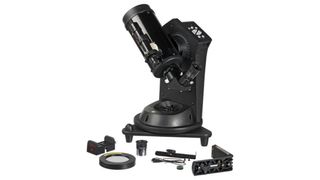
Sky-Watcher Heritage-90P Virtuoso
Our expert review:
Specifications
Reasons to buy
Reasons to avoid
✅ You want something portable: This telescope is ideal for taking with you on night-time adventures out in the field, or even taking on vacation.
✅ You're looking for great imagery: You'll get rich colors and high contrast with this telescope.
✅ You want neat and easy tracking: The built-in tracking on this telescope makes it easy to navigate the night sky.
❌ You're worried about lens damage: The lens on the front of this model is quite exposed.
❌ You want a highly effective red dot finder: We thought that red dot finder on this telescope could definitely be improved, though it was fine for basic positioning.
🔎 Sky-Watcher Heritage-90P Virtuoso: As the most portable option on our list, this would be a great choice for those who like to take their telescope on stargazing trips out in the field. ★★★★½
It may be small, but the SkyWatcher Heritage-90P Virtuoso is a very capable telescope. It makes use of two mirrors and a meniscus lens, meaning an impressive 1.25m focal length can be squeezed into a tube that's only 28cm long. Its size makes it one of the most portable telescopes we've included in this guide, which makes it a great choice for taking out into the field or traveling around with.
The Heritage-90P Virtuoso has a Maksutov-Cassegrain design. Similar to a refractor telescope, it's known for providing sharp and high-contrast images — and this model is no different. It's a fantastic choice for observing planetary surfaces, and it does a stand-out job of showcasing details like the bands and moons of Jupiter.
The included red dot finder isn't the best, but the motorized Virtuoso mount makes it easy to point the telescope at objects in the sky. The smooth slewing controls allow you to track objects as they move across the sky, making it easier to keep them in view.
You can upgrade the mount at any time via Sky-Watcher's Synscan GoTo device, giving it the ability to find more than 40,000 objects in the night sky for you automatically. It can also track the sky to counteract the Earth's rotation, keeping your object of interest within the field of vision at all times.
If you are interested in a more powerful telescope with a similarly compact design and want to fast-track to the complete GoTo system, you might want to check out the Heritage-90's big brother, the Skymax-127 Virtuoso GTI.
- Check out our telescope deals hub to see if you can pick up a bargain
| Attributes | Notes | Rating |
|---|---|---|
| Design | Super compact and portable. | ★★★★★ |
| Performance | Great colors and contrast. | ★★★★ |
| Functionality | Smooth slewing and tracking. | ★★★★ |
Best for beginners





Specifications
Reasons to buy
Reasons to avoid
✅ You want a multifunctional telescope at an affordable price: the innovative smartphone mount will allow you to try your hand at some basic astrophotography along with your stargazing.
✅ You're mainly interested in viewing the planets and the moon: this telescope does a good job of bringing the planets and moon into sharp focus, but it doesn't let in enough light for deep-sky viewing.
❌ You want to view deep-space objects: though this telescope can view some more distant objects, the aperture isn't up to true deep-space observation.
🔎 Celestron Inspire 100AZ refractor telescope: with some nice additional features like a smartphone mount and built-in red light, this telescope is a great way for beginners to start exploring the moon and planets. ★★★★
When we reviewed the Celestron Inspire 100AZ refractor telescope, we found it to be a great telescope for beginners looking to get a better view of the moon and the planets without breaking the bank. You can typically pick up this telescope between $300 and $350, which makes it one of the most affordable options on this list.
There is a downside to that, however. At this price point, you don't get a fancy motorized mount: Instead, the Inspire 100AZ has a simple altazimuth mount which requires manual movement via a panhandle. More traditional stargazers may prefer this approach, however, and we think it's a fair trade-off given the price point of this telescope. Pair it with a stargazing app if you want to make the process a little easier to get used to.
This telescope offers a neat feature for astrophotography enthusiasts — the lens cap also functions as a smartphone mount, allowing you to capture stunning photos of planets and the night sky with your phone. It's a lightweight telescope that we found easy to set up and take down, however, it's worth noting that the optical tube is 26 inches (660mm) long, so it does require a bit of space.
Although the 4-inch aperture may not gather sufficient light for distant celestial objects, this telescope offers a decent view of the planets, particularly with the 20mm eyepiece. We observed detailed moon craters and even caught a glimpse of Andromeda (M31) along with some of the brighter star clusters.
It may not be the best telescope out there, but we think it's a solid choice for beginners and offers good value for the money, with some fun extra features.
- Read our full Celestron Inspire 100AZ review
| Attributes | Notes | Rating |
|---|---|---|
| Design | Easy to set up and take down. | ★★★★ |
| Performance | Good for viewing the moon and planets. | ★★★ |
| Functionality | Handy additional features. | ★★★★ |
Best combination package
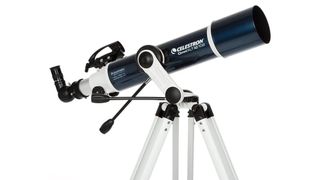
Celestron Omni XLT 102
Our expert review:
Specifications
Reasons to buy
Reasons to avoid
✅ You want something sturdy: the mount on this telescope is well matched to its weight and feels solid and substantial.
✅ You're looking for an equatorial mount: this telescope package comes with an effective equatorial mount that can even be operated one-handed.
❌ You're particularly interested in deep-space objects: this telescope gives detailed views of the planets, but isn't quite up to viewing deep-space objects.
🔎 Celestron Omni XLT 102: this telescope offers a nice combination package that feels sturdy and robust. It includes an equatorial mount and can give you a detailed view of the planets. ★★★★
The Celestron Omni XLT 102 is a unique package featuring a high-quality telescope and mount combination. It's easy to set up and doesn't require any tools, making it an excellent choice for both beginners and experienced astronomers.
The 4-inch F/10 achromat gives fine views, and its focal length makes it a good match for some of the best planetary eyepieces. Unfortunately, only one eyepiece is supplied in the box, but with the addition of a 10mm and Barlow lens (take a look at our best eyepieces guide), you can achieve a magnification of 36x, 72x, 100x and 200x. At this top end, the Omni XLT 102 will provide you with some lovely details of our neighboring planets.
There's also a 150mm and 120mm model of this telescope (you can read our Celestron Omni XLT 120 review to find out more). All three models use the same CG-4 equatorial mount, but we've found the larger telescopes to come close to the weight limit of the mount, so that's something to bear in mind.
It may take some time to get used to the equatorial mount on this Omni XLT 102, particularly if you've not used one before. On equatorial mounts, the polar axis is parallel to the Earth's rotation, but once you've adjusted to using it, you'll likely find that tracking planets is manageable with just one hand. If a completely hands-free experience is something you'd like, there's the option to upgrade to a dual-axis auto-tracking kit which can be installed on this telescope.
- Find one of the Best telescopes for kids for those with younger astronomers
| Attributes | Notes | Rating |
|---|---|---|
| Design | Sturdy equatorial mount. | ★★★★ |
| Performance | High magnification of planets. | ★★★★ |
| Functionality | Can be improved with added accessories. | ★★★ |
Best for precision
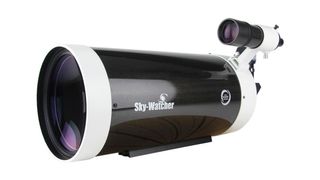
Sky-Watcher Skymax-180 PRO (HEQ5 PRO SynScan)
Our expert review:
Specifications
Reasons to buy
Reasons to avoid
✅ You're looking for excellent optics: the images produced by this telescope are sharp, vibrant and detailed.
✅ You want a larger aperture: the 7.1-inch primary mirror on this telescope performs incredibly well.
❌ You want something that's very portable: although this telescope is relatively compact, it's still quite heavy to move around.
❌ You're on a tight budget: this is quite a pricey telescope and there are plenty of more affordable options out there.
🔎 Sky-Watcher Skymax-180 PRO: this telescope is a beast when it comes to optics and produces incredible views of the planets and moons, but it's quite an investment. ★★★★
The Sky-Watcher Skymax-180 PRO is designed specifically for exploring the solar system. Its long focal length and high-resolution optical system deliver flawless views of the planets, capturing vibrant details similar to a more expensive apochromatic refractor. A 7.1-inch primary mirror also provides enough light to reveal many of the moons in our solar system.
We thought the included 2-inch/28mm eyepiece didn't fully unlock the telescope's potential, so we'd recommend investing in a more powerful 8mm or 10mm planetary eyepiece that will further enhance its optics.
The Skymax-180 PRO is mounted on a robust HEQ5 PRO equatorial mount, specifically crafted to handle substantial weights for optimal precision and stability. This setup is perfect for various photography applications, such as detailed planetary and lunar imaging and capturing images of various deep-sky objects.
If you plan to purchase another telescope in the future, it is beneficial to 'over-mount' the scope. This means choosing a mount rated for a heavier payload than the telescope you currently have so that you won't have to upgrade the mount in the future. It will also provide additional stability, especially at higher magnifications.
Many visual observers and astrophotographers favor the Skymax-180 PRO paired with the HEQ5 PRO mount. This versatile and robust combination is suitable for a variety of applications, making it an excellent all-in-one choice.
- Read our guide on the Best telescopes for deep space
| Attributes | Notes | Rating |
|---|---|---|
| Design | Excellent optical system. | ★★★★ |
| Performance | High-resolution, vibrant views. | ★★★★ |
| Functionality | Works best with extra eyepieces. | ★★★★ |
Best for functionality





Specifications
Reasons to buy
Reasons to avoid
✅ You're a beginner: we think this is a great option for beginners because it doesn't require any prior knowledge.
✅ You want something portable: this telescope is lightweight and convenient for taking out in the field with you.
❌ You're looking for great optics: there is some image fall-off around the edge of the field of view.
❌ You like the feel of a premium product: this telescope is mostly housed in plastic and we found the tripod a bit flimsy.
🔎 Celestron AstroFi 102: this telescope would suit beginners who want to use an app and plan on taking their telescope out and about. ★★★½
We think the Celestron Astro Fi 102 telescope is a great choice for newcomers to astronomy and those with a keen interest in technology. With a motorized mount and SkyPortal app support, this isn't a great telescope for purists, but if you're keen to embrace some of the best skywatching technologies, you're going to have a great time using this telescope.
In our Celestron Astro Fi 102 review, we praised just how well the SkyPortal app worked. Available on both iOS and Android, it features a database of around 100,000 celestial objects, any of which you can select and ask the telescope to automatically slew towards. The telescope moves quietly and quickly — and what's particularly neat is that you can even connect a Bluetooth video game controller to position the scope.
While the telescope may not have the premium feel of some high-end models, its lightweight and portable design makes it ideal for carrying to various stargazing locations. However, it's still important to ensure adequate protection during transport to prevent any potential damage to the telescope.
With suitable eyepieces and conditions, this telescope offers clear, close-up views of the Moon, Saturn's rings, Mars, Jupiter, Uranus, and Neptune.
- Read our full Celestron Astro Fi 102 review
| Attributes | Notes | Rating |
|---|---|---|
| Design | Lightweight, but tripod could be sturdier. | ★★★ |
| Performance | Nice automatic motorized mount. | ★★★★ |
| Funcionality | Works well with SkyPortal app. | ★★★★ |
Best budget option






Specifications
Reasons to buy
Reasons to avoid
✅ You're a beginner on a budget: this telescope offers an affordable way to start viewing the planets.
✅ You like using an app: the StarSense app makes it easy to operate this telescope and it even comes with a built-in smartphone holder.
❌ You want precise optical clarity: this telescope does suffer from some chromatic aberration on bright objects
❌ You want to view deep-sky objects: while it's good for viewing the planets, this telescope can't offer a proper view of deep-sky objects.
🔎 Celestron StarSense Explorer LT 114AZ: this is a good entry-level telescope for seeing the planets, but the optics won't allow you to see further objects like galaxies. ★★★
During our Celestron StarSense Explorer LT 114AZ review, we established that this telescope was perfect for viewing the moon and planets as it's designed to give a high magnification of bright objects.
However, as it's a more affordable option than others, Celestron had to make some compromises on image quality. You may notice some chromatic aberration (also known as color fringing) around the edges when you observe bright objects or that the colors aren't as accurate as the ones observed with more premium models.
This telescope comes with a Barlow lens, which means you can use it to get beautiful views of celestial objects such as Saturn, Jupiter or the moon. However, it doesn't capture enough light to enable you to see objects deep in space.
One of our favourite things about the StarSense Explorer LT 114AZ is its compatibility with Celestron's own StarSense app. We love this app, as it makes aligning your telescope quickly and easy. It's particularly great for beginners as it takes all the difficulty out of the process, allowing you to get to viewing the planets without any fuss.
This telescope has a 'push to' scope rather than a GoTo scope, which means it doesn't automatically move to find your chosen target. Instead, you'll need to use arrows on your phone screen which guide you to the right position. It's a little fiddly, particularly as there are no slow-motion controls, but it's still very helpful for newcomers over complete manual tracking.
- Read our full Celestron StarSense Explorer LT 114AZ review
| Attributes | Notes | Rating |
|---|---|---|
| Design | Useful phone dock. | ★★★ |
| Performance | Optics limited to planets. | ★★★ |
| Functionality | StarSense app alignment works well. | ★★★ |
Best telescopes for seeing planets 2024: Frequently Asked Questions
Which telescope is best for viewing planets: Refractors or reflectors?
The answer will depend on personal preference; we recommend trying both types and seeing which one you like best.
If you're on a budget, you may want to consider opting for a smaller refractor telescope over a larger reflector model with a similar price tag. The secondary mirrors and struts in Newtonian reflectors risk distorting the incoming light and reducing image contrast.
Larger refractor telescopes are usually considered the gold standard for skywatching, but they're generally big, heavy, and very expensive. A compound telescope like a Maksutov-Cassegrain or Schmidt-Cassegrain can be a good compromise. They provide great image quality but tend to be more compact and affordable than refractor telescopes.
What telescope eyepiece do I need to view planets?
When you're looking for a telescope specifically to look at planets, there are other optical accessories you'll want to consider buying too.
For example, eyepieces with greater magnification will be beneficial to get clearer views of planets, which are distant objects in the night sky. So if you're looking to observe planets, choose an eyepiece with medium to high magnification.
Barlow lenses can also help you in that department, as they can attain magnifications between 120-250x depending on the limit of your telescope.
What telescope do I need to see Saturn's rings?
The answer to this depends on which telescope and eyepiece combination you opt for. Both of these have a focal length, but eyepieces also have an apparent field of view, which, used alongside focal lengths, can help you determine your telescope's true field of view.
The basic formula to calculate which telescope or eyepiece you need to see Saturn's rings is as follows:
Telescope focal length / eyepiece focal length = Magnification
Apparent field of view / Magnification = True field of view
You can then compare the true field of view of the combination against the size of any object you wish to observe, such as Saturn's rings or Jupiter's red spot to see how well you'll be able to view it.
It's important to remember, though, that surface brightness and atmospheric conditions, as well as weather, will ultimately decide how well you can view any night sky object, including planets.
How we test the best telescopes for seeing planets
At Space.com, we are confident that our recommendations for the best telescopes are honest, reliable, and up-to-date. We pride ourselves on putting every telescope through a rigorous review process that tests each instrument thoroughly. Our expert staff and knowledgeable freelance contributors carefully evaluate each telescope to ensure that our reviews are fair, unbiased, and based on real-life experience.
During the review process, we consider several aspects, such as the telescope's construction and design, performance in the field, and function as an optical instrument. We also consider each telescope's intended use, class, and price to ensure that we compare apples to apples.
We evaluate how easy it is to set up each telescope, whether computerized or motorized mounts are reliable and quiet and whether the telescope comes with appropriate accessories like eyepieces and tripods. If we think a particular telescope would benefit from other kit to make the most of it, we'll suggest it. This gives you the best experience possible. At Space.com, we maintain complete editorial independence to ensure that our buying guides and reviews are reliable, transparent, and unbiased. We are confident that our buying advice on telescopes is the best in the market, so you can make informed decisions about purchasing an instrument or not.
Aperture: Diameter of the primary mirror or lens, which allows a telescope to collect light.
Field of view: Area of sky visible through the eyepiece.
Focal length: A telescope's tube length. Short focal lengths offer a wide field of view and a small image.
Focal ratio: Also known as the telescope's speed. Small focal ratios provide lower magnifications, a wide field of view and a brighter image.
Magnification: Relationship between the telescope's optical system and the eyepiece.
Unlike the deep sky, which remains almost unchanged throughout our lives, the planets constantly bring us new and sometimes surprising reasons to look again. They're easy to find and inspiring to take in — real worlds that our descendants or even we may visit one day.
Any telescope can make them look impressive, but a well-tuned high-contrast instrument is what is needed to really do them justice, and you'll be thankful to have one to hand when something special occurs, like the arrival of an incredible gas giant storm, or a night of exceptionally steady seeing that invites you to max out the power. If you plan to take your own astrophotos, it's well worth considering a telescope mount with tracking capability, altazimuth or equatorial — both are suitable for short exposures. At such long focal lengths, the Earth's rotation quickly moves things out of the field of view, and dedicated planetary imaging cameras have small sensors. Regardless of which telescope you choose, you're in for an exciting new hobby as a Solar System explorer. Enjoy the magnificent highlights of our celestial neighborhood.
Join our Space Forums to keep talking space on the latest missions, night sky and more! And if you have a news tip, correction or comment, let us know at: community@space.com.
Get the Space.com Newsletter
Breaking space news, the latest updates on rocket launches, skywatching events and more!

Tom Kerss is an astronomer and the author of numerous best-selling books about the night sky for both adults and children, including Northern Lights, Diamonds Everywhere and the Starry Stories Series. He shares his passion for the stars with people all over the world, delivering courses, podcasts and media interviews. Having worked in Hawaii, Chile, Namibia, Iceland and Norway, Tom loves nothing more than to seek out the darkest and most beautiful skies on Earth, escaping his light-polluted home of London. He has a background in astrophysics and formerly worked at the Royal Observatory in Greenwich.
- Jase Parnell-BrookesChannel Editor
- Kimberley LaneContributing writer
- Tantse WalterContributing Writer